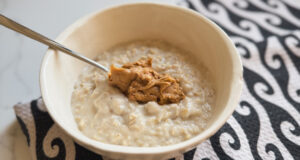
I run year-round, but winter is by far my favorite time to go jogging. When it’s cold and crisp out, I can go much longer and harder, often doubling the length of my summertime routes. Afterward, I want nothing more than to eat like a bear preparing to hibernate for the winter.
I always figured my increased appetite was merely due to the fact that I exercise more in the cooler months. While that’s undoubtedly a factor, research published by Nature in 2023 suggests that the state of being chilly can make your stomach growl, too.
“When you’re cold, your body has to work harder to keep itself warm, and that burns more calories and can make you feel hungrier,” says Dana Ellis Hunnes, a senior clinical dietitian at the University of California, Los Angeles Medical Center (UCLA) and assistant professor at UCLA’s Fielding School of Public Health.
Your nutrition needs fluctuate with the seasons, and paying attention to those changes is crucial to getting the most out of your wintertime activities. Here’s why.
Why You Feel Hungrier When It’s Cold Out
Your internal organs function best when your core temperature hovers around 98.6 degrees Fahrenheit; anything below that automatically triggers your body to warm itself. And if you’re revving too hot, your body will naturally try to dissipate heat. This process, called thermoregulation, keeps your heart, brain, and lungs performing optimally.
“It’s a well-established phenomenon that your body needs more energy to maintain its core temperature when it’s cold out,” says Li Ye, a professor in the Department of Neuroscience at the Scripps Research Institute and lead researcher of the Nature study.
One way your body maintains its warmth is by shivering, Ye says. Trembling—which occurs when your muscles involuntarily contract and relax super quickly—requires energy that, in turn, ups your body temperature to a toastier level.
In my conversation with Hunnes, I learned a second reason we humans tend to scarf down everything in sight after spending time in bone-chilling weather. It takes a lot of work for your body to digest and break down food, and all of that effort warms you up; this is called the thermic effect of food, she says.
Other but slightly less impactful factors can further exacerbate your cold-weather hunger. For example, people who struggle with seasonal affective disorder (SAD), a type of depression that can be triggered by the reduction of daylight in the fall and winter months, tend to crave carb-dense foods.
Moreover, the added stress that goes hand in hand with the holiday season may also cause your adrenal glands to produce more cortisol, the stress hormone. This can give you an insatiable appetite, or what we know colloquially as “stress eating.” A boost in cortisol production might make you more inclined to seek out food.
An Increase in Appetite Can Affect Your Workouts
During cold-weather activities, you likely need to eat more to compensate for all the extra calories your body’s burning, Hunnes says. “You may need to eat more frequent, smaller meals or complex carbs to carry out the same level of activity,” she says.
But what, exactly, makes complex carbs so useful? According to the Centers for Disease Control and Prevention, they contain more nutrients and fiber than refined or simple carbs. In other words, complex carbs, like sweet potatoes and legumes, fill you up and energize you for longer than, say, a fistful of Tootsie Rolls. So, if you don’t fuel yourself properly, your body will settle into a lethargic state to conserve whatever remaining energy you have, says Ye.
Ye’s study investigated the effects of cold temperatures on mice to understand what is happening in the body that makes animals hungrier when cold. Per his preliminary findings, specific neurons activated in cold conditions prompted the rodents to scavenge for food.
Furthermore, when the mice couldn’t find food, they became sluggish and chose to hunker down in the corner of their cage. “The default response is to perform less vigorously to conserve energy,” says Ye. I asked if those findings might apply to humans. He said they certainly might—though more research is needed to verify this.
According to Nyree Dardarian, an assistant clinical professor and director of the Center for Nutrition and Performance at Drexel University, our physical and cognitive performance suffers when we don’t consume enough nutrients. Fatigue often follows, or you grow tired more quickly and even think more slowly; this may prevent you from finishing your hike or swerving in time to avoid cycling right over a pothole. As such, operating at a slower pace, even if it’s just a two-second lag, can significantly increase your risk of an injury, Dardarian says.
How to Tailor Meals for Your Winter Adventures
Let’s say you’re in the mood to go on a long, wintry hike. Per experts’ advice, it’s in your best interest to do some meal prep.
Eat a Protein-Rich Meal Beforehand
Dardarian suggests scheduling a meal roughly two hours before you plan to start. Make sure it’s protein-dense; opt for lean meats, beans, Greek yogurt, and unsaturated fats such as nuts, seeds, avocados, fatty fish, and complex carbohydrates, Dardarian says.
Embrace the Urge to Snack
Enjoy a nourishing snack 30 minutes before your start time. Because you’ve already burned through some of the food you ate a couple of hours prior, you want to boost your energy levels one more time before hitting the trail, Dardarian says.
Pack some snacks if you plan to go skiing for a few hours. Being in the cold for an extended period will inevitably deplete your energy stores and make you ravenous. Having a treat or two handy will be a lifesaver when hunger strikes.
Don’t Forget the Carbs Mid-Workout
Regarding snacking during an activity, carbohydrates are king. “Your brain is looking for an immediate source of generating heat, and carbs are effective at doing that,” Ye says. The reason, he says, is that carbs contain glucose, and your body tends to warm up when it breaks down glucose.
Dardarian recommends eating fruit, like a banana or grapes, fruit snacks such as Mott’s Assorted Fruit Flavored Snacks (no need to get organic ones, she says), energy gels, or a bag of pretzels about 1.5 hours into your activity.
It’s Totally Normal—and OK—to Lean into Your Natural Hunger Cues
When hunger pangs intensify, your body is trying to tell you something. Ye’s advice: don’t ignore those cues. “Your body knows what it wants—follow its calls,” he says.
Don’t feel guilty about eating more when it’s cold out. Remember, there’s a legitimate physiological reason you feel hungrier. Your body needs the extra fuel to perform in the cold.
Shift your focus away from self-shaming thoughts and embrace all the joy food offers, says Dardarian. Sharing meals with friends and family fosters connection and well-being, too. Food is nourishment, after all—“not just for the body, but for relationships.”
Maybe a pre-jog apple will cut it in July, but a Granny Smith won’t be enough fuel for a two-hour-long winter run. As the year comes to a close, I’m challenging myself (and you) to eat more and self-punish less. If I’m being honest, eating something savory like a chicken avocado sandwich before a run—a recommendation I got from Dardarian—might be the best and tastiest health advice I’ve ever received.
Want more of Outside’s Health stories? Sign up for the Bodywork newsletter.




